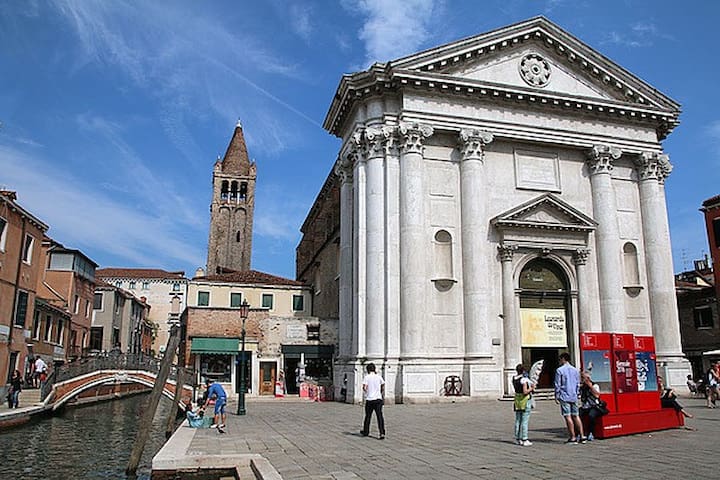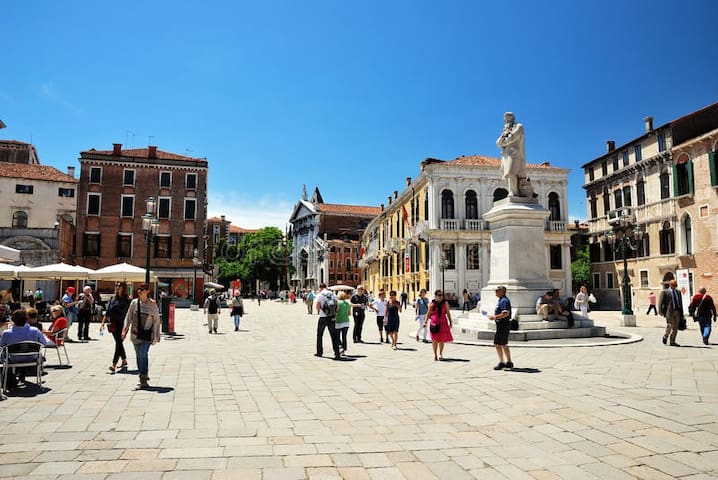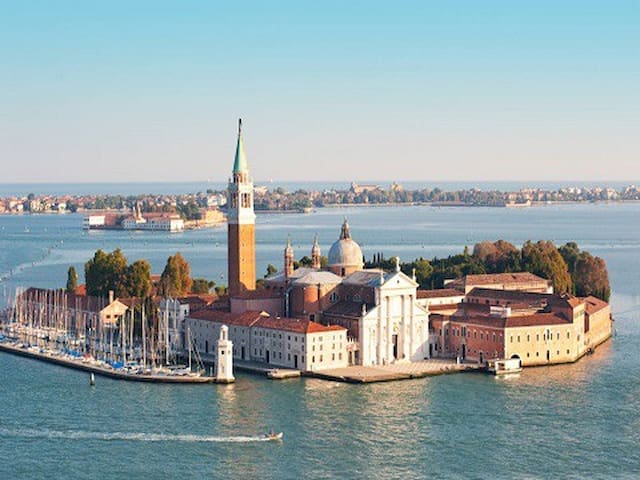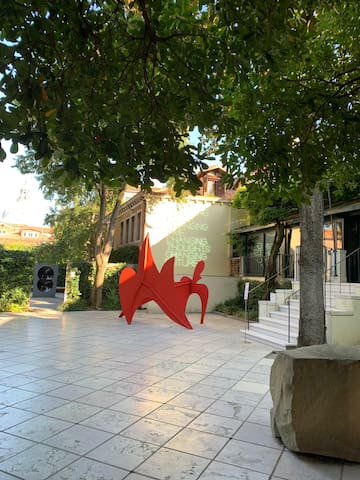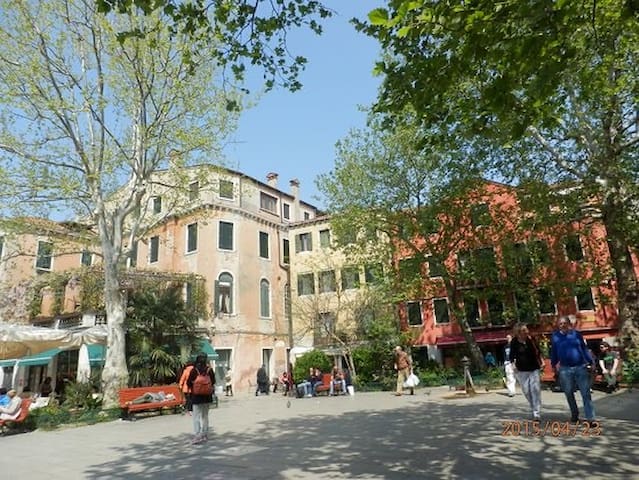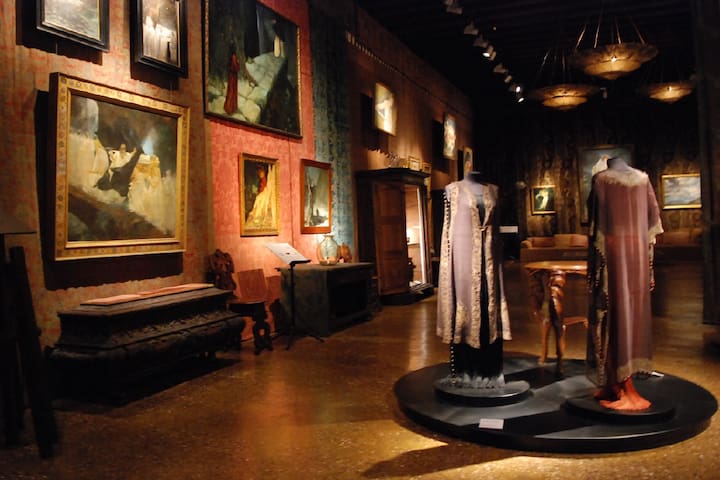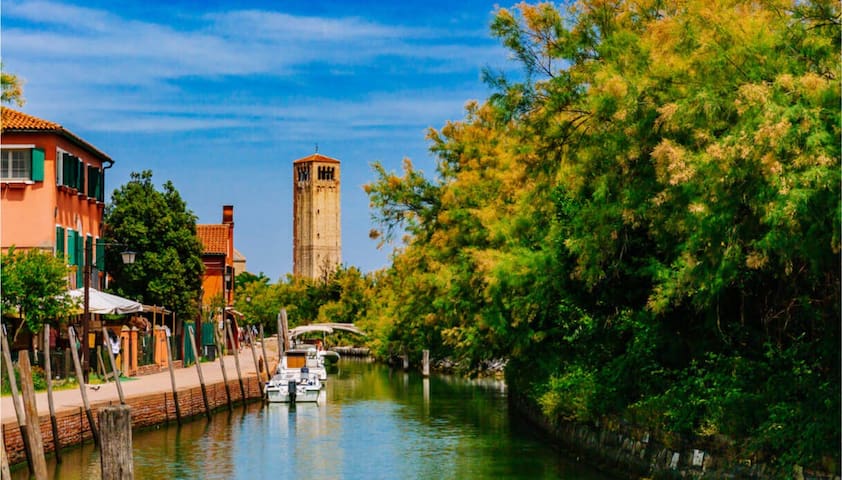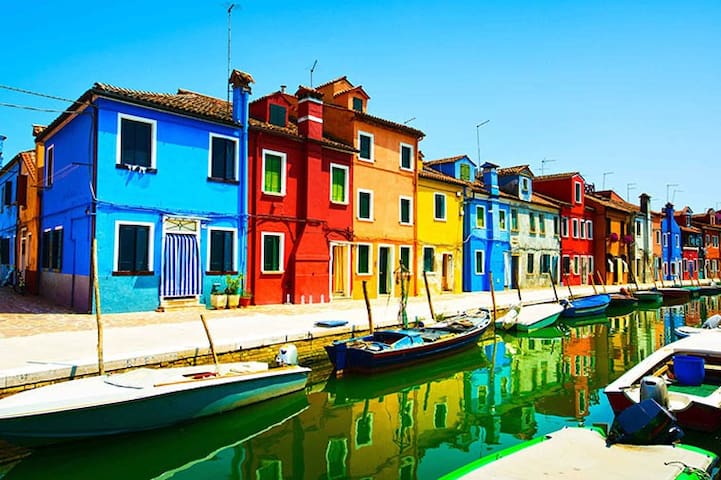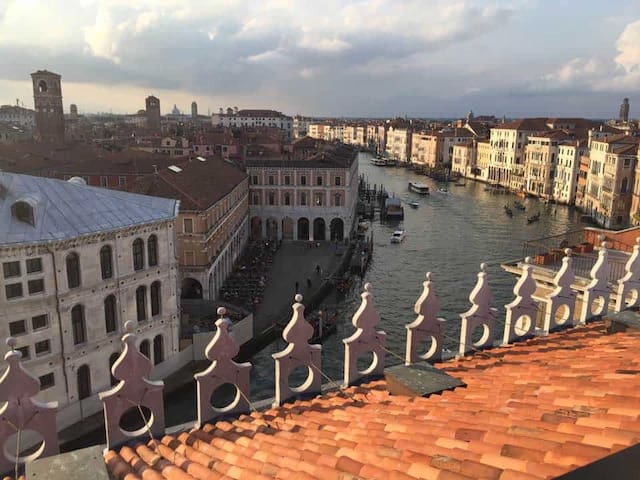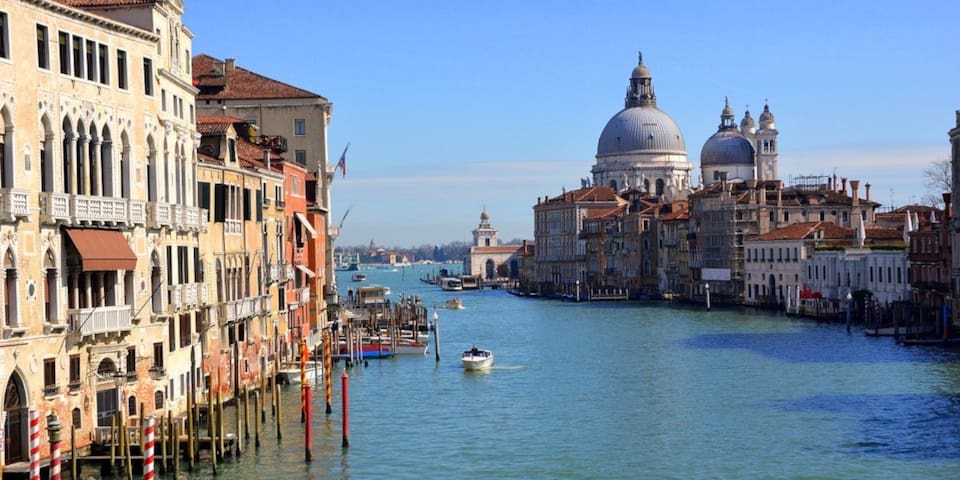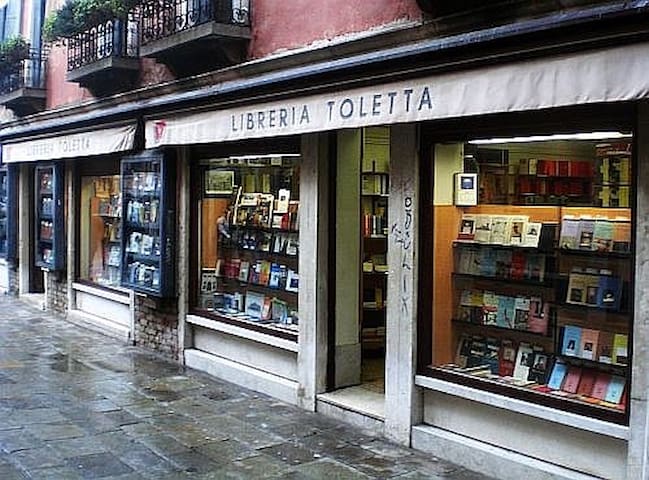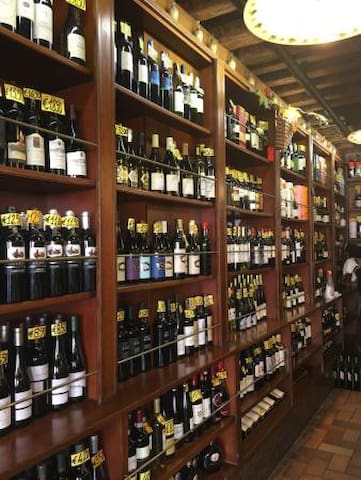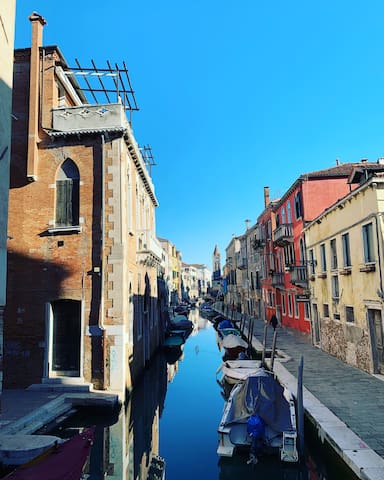Visite turistiche
It’s a very nice church, 3 minutes of walking from Carmini House and far from the tourist areas. ideal for starting the visit of Venice.
Santa Maria dei Carmini - Santa Maria del Carmelo
2612 Sestiere DorsoduroIt’s a very nice church, 3 minutes of walking from Carmini House and far from the tourist areas. ideal for starting the visit of Venice.
Campo Santa Margherita is located 3/4 minutes of walking from Carmini House and is one of the most beautiful “Campi” in Venice. place of bars and restaurants and full of sunshine and life.
126 Recomendado por los habitantes de la zona
Campo Santa Margherita
Campo Santa MargheritaCampo Santa Margherita is located 3/4 minutes of walking from Carmini House and is one of the most beautiful “Campi” in Venice. place of bars and restaurants and full of sunshine and life.
Campo San Barnaba is absolutely amazing. It is located about 5/6 minute of walking to Carmini House and you can find some tipical venetian places, like “Barca of Frutta e Verdura”, a green grocer placed on a real boat.
6 Recomendado por los habitantes de la zona
Campo San Barnaba
Campo San Barnaba is absolutely amazing. It is located about 5/6 minute of walking to Carmini House and you can find some tipical venetian places, like “Barca of Frutta e Verdura”, a green grocer placed on a real boat.
it is located 6/7 minutes of walking from Carmini House and is one of the most beautiful churches in Venice. Highly recommended.
178 Recomendado por los habitantes de la zona
Basílica dei Frari
it is located 6/7 minutes of walking from Carmini House and is one of the most beautiful churches in Venice. Highly recommended.
Campo Santo Stefano
Campo Santo StefanoHighly recommended
San Giorgio Maggiore
It’s in front of Piazza San Marco
Doge's Palace
1 P.za San MarcoThe Peggy Guggenheim Collection is a museum on the Grand Canal in Venice based in Palazzo Venier dei Leoni, part of the Solomon R. Guggenheim Foundation Mainly collecting the personal art collection of Peggy Guggenheim (1898-1979), ex-wife of artist Max Ernst and grandson of the magnate Solomon R. Guggenheim, this museum, once also the private home of Peggy Guggenheim, collects a somewhat smaller and more concentrated collection than those of the other Guggenheim museums. Italian museums in the field of European and American art of the first half of the twentieth century.
Starting from June 2017, after 37 years at the helm, Philip Rylands leaves the Peggy Guggenheim Collection in Venice to a new direction: Karole P. B. Vail arrives in office who at the same time assumes a coordinating position also of the Solomon R. Guggenheim, based in New York.
Highly recommended
433 Recomendado por los habitantes de la zona
Colección Peggy Guggenheim
701-704 DorsoduroThe Peggy Guggenheim Collection is a museum on the Grand Canal in Venice based in Palazzo Venier dei Leoni, part of the Solomon R. Guggenheim Foundation Mainly collecting the personal art collection of Peggy Guggenheim (1898-1979), ex-wife of artist Max Ernst and grandson of the magnate Solomon R. Guggenheim, this museum, once also the private home of Peggy Guggenheim, collects a somewhat smaller and more concentrated collection than those of the other Guggenheim museums. Italian museums in the field of European and American art of the first half of the twentieth century.
Starting from June 2017, after 37 years at the helm, Philip Rylands leaves the Peggy Guggenheim Collection in Venice to a new direction: Karole P. B. Vail arrives in office who at the same time assumes a coordinating position also of the Solomon R. Guggenheim, based in New York.
Highly recommended
The Basilica of San Marco is the enchanting building that represents the magnificence of the Republic of Venice, during the thousand years of life of the Serenissima.
With its monumental arches that project onto Piazza San Marco, it is called the Golden Basilica, due to the more than one thousand square meters of mosaic tiles made with the gold leaf with which it is covered.
211 Recomendado por los habitantes de la zona
Tesoro de la Basílica de San Marcos
328 P.za San MarcoThe Basilica of San Marco is the enchanting building that represents the magnificence of the Republic of Venice, during the thousand years of life of the Serenissima.
With its monumental arches that project onto Piazza San Marco, it is called the Golden Basilica, due to the more than one thousand square meters of mosaic tiles made with the gold leaf with which it is covered.
Piazza San Marco
The Scuola Grande di San Rocco (about 7 minute of walking from Carmini House) is a building in Venice, northern Italy. It is noted for its collection of paintings by Tintoretto and generally agreed to include some of his finest work.
The building is the seat of a confraternity established in 1478, named after San Rocco, popularly regarded as a protector against plague. The members of the "Confraternity of St. Roch" were a group of wealthy Venetian citizens. The site they chose for their building is next to the church of San Rocco which houses the remains of the saint.
In 1564 the painter Tintoretto was commissioned to provide paintings for the Scuola, and his most renowned works are to be found in the Sala dell'Albergo and the Sala Superiore. All the works in the building are by him, or his assistants, including his son Domenico: they were executed between 1564 and 1587. Works in the sala terra are in homage to the Virgin Mary, and concentrate on episodes from her life. In the sala superiore, works on the ceiling are from the Old Testament, and on the walls from the New Testament. Together, they show the biblical story from Fall to Redemption.
A sculpture of Tintoretto with his paintbrushes is featured, as well as a relief carved to look like a bookcase.
165 Recomendado por los habitantes de la zona
Scuola Grande di San Rocco
The Scuola Grande di San Rocco (about 7 minute of walking from Carmini House) is a building in Venice, northern Italy. It is noted for its collection of paintings by Tintoretto and generally agreed to include some of his finest work.
The building is the seat of a confraternity established in 1478, named after San Rocco, popularly regarded as a protector against plague. The members of the "Confraternity of St. Roch" were a group of wealthy Venetian citizens. The site they chose for their building is next to the church of San Rocco which houses the remains of the saint.
In 1564 the painter Tintoretto was commissioned to provide paintings for the Scuola, and his most renowned works are to be found in the Sala dell'Albergo and the Sala Superiore. All the works in the building are by him, or his assistants, including his son Domenico: they were executed between 1564 and 1587. Works in the sala terra are in homage to the Virgin Mary, and concentrate on episodes from her life. In the sala superiore, works on the ceiling are from the Old Testament, and on the walls from the New Testament. Together, they show the biblical story from Fall to Redemption.
A sculpture of Tintoretto with his paintbrushes is featured, as well as a relief carved to look like a bookcase.
it is a very small but special church, 5 minutes of walking from Carmini House and far from the tourist areas. Ideal if you want to visit one more place in a short time.
19 Recomendado por los habitantes de la zona
San Nicolò dei Mendicoli
1907 Calle S. Nicolòit is a very small but special church, 5 minutes of walking from Carmini House and far from the tourist areas. Ideal if you want to visit one more place in a short time.
It’s very close to Punta della Dogana. I recommend visiting them together.
161 Recomendado por los habitantes de la zona
Basílica de Santa María de la Salud
1 DorsoduroIt’s very close to Punta della Dogana. I recommend visiting them together.
In Campo San Giacomo dall'Orio stands the church of the same name, one of the most ancient Venetian churches.
The simple façade, which almost does not look like that of a sacred building, faces a tiny square characterized by a fountain.
The foundation of the church should date back to the 9th century even if the first document that mentions it dates back to 1089. In 1225 it was rebuilt in the Byzantine style and decorated with very particular elements including a green marble column brought from Byzantium as a trophy of war during the Fourth Crusade.
Inside it is worth noting the beautiful pictorial cycle of Palma il Giovane in the Old Sacristy and in the Chapel of the Most Holy.
Not far from San Giacomo dell'Orio rises Palazzo Mocenigo which in 1954 was donated to the city of Venice by the owner Alvise Mocenigo, descendant of an ancient and noble patrician family who gave famous Doges to the Serenissima.
7 Recomendado por los habitantes de la zona
Campo San Giacomo da l'Orio
Campo San Giacomo da l'OrioIn Campo San Giacomo dall'Orio stands the church of the same name, one of the most ancient Venetian churches.
The simple façade, which almost does not look like that of a sacred building, faces a tiny square characterized by a fountain.
The foundation of the church should date back to the 9th century even if the first document that mentions it dates back to 1089. In 1225 it was rebuilt in the Byzantine style and decorated with very particular elements including a green marble column brought from Byzantium as a trophy of war during the Fourth Crusade.
Inside it is worth noting the beautiful pictorial cycle of Palma il Giovane in the Old Sacristy and in the Chapel of the Most Holy.
Not far from San Giacomo dell'Orio rises Palazzo Mocenigo which in 1954 was donated to the city of Venice by the owner Alvise Mocenigo, descendant of an ancient and noble patrician family who gave famous Doges to the Serenissima.
The Gallerie dell'Accademia in Venice (6/7 minutes of walking from Carmini House) is an Italian state museum. They are located in the Dorsoduro district at the foot of the Accademia bridge, in what until the early nineteenth century was the vast complex formed by the church of Santa Maria della Carità, the convent of the Lateran Canons and the Scuola Grande di Santa Maria della Charity (the entrance is for the portal of the latter). They take their name from the Academy of Fine Arts, which opened them in 1817 and shared their headquarters until 2004.
They collect the best collection of Venetian and Venetian art, especially linked to paintings from the period from the fourteenth to the eighteenth century: among the major artists represented are Tintoretto, Giambattista Pittoni, Tiziano, Canaletto [2], Giorgione, Giovanni Bellini, Vittore Carpaccio, Cima da Conegliano and Veronese. There are also other forms of art such as sculptures and drawings, including the famous Vitruvian Man by Leonardo da Vinci (exhibited only on special occasions).
369 Recomendado por los habitantes de la zona
Gallerie dell'Accademia
1050 Campo della CaritàThe Gallerie dell'Accademia in Venice (6/7 minutes of walking from Carmini House) is an Italian state museum. They are located in the Dorsoduro district at the foot of the Accademia bridge, in what until the early nineteenth century was the vast complex formed by the church of Santa Maria della Carità, the convent of the Lateran Canons and the Scuola Grande di Santa Maria della Charity (the entrance is for the portal of the latter). They take their name from the Academy of Fine Arts, which opened them in 1817 and shared their headquarters until 2004.
They collect the best collection of Venetian and Venetian art, especially linked to paintings from the period from the fourteenth to the eighteenth century: among the major artists represented are Tintoretto, Giambattista Pittoni, Tiziano, Canaletto [2], Giorgione, Giovanni Bellini, Vittore Carpaccio, Cima da Conegliano and Veronese. There are also other forms of art such as sculptures and drawings, including the famous Vitruvian Man by Leonardo da Vinci (exhibited only on special occasions).
It’s a very special place. Highly recommended
48 Recomendado por los habitantes de la zona
Palazzo Moro Lin
3242 Calle MorolinIt’s a very special place. Highly recommended
The Church of San Zaccaria, a short distance from Piazza San Marco, is one of the most beautiful in Venice, but don't just admire its fifteenth-century facade or its interiors full of works of art. Remember, when you reach the chapel of San Tarasio, in correspondence with one of the apses, to go down the steps leading to the crypt: this is where the building reveals one of its most evocative aspects, and that the less informed tourist can miss. You will find yourself in an environment with three naves with columns and cross vaults. In this place the first doges of the Serenissima were buried. Today, as happens in many Venetian buildings, the basements are constantly flooded, but the presence of water has transformed the environment making it fascinating and unique: the columns and vaults are mirrored, doubling the spaces, adding depth and creating new perspectives.
43 Recomendado por los habitantes de la zona
Chiesa di San Zaccaria
4693 Campo S. ZaccariaThe Church of San Zaccaria, a short distance from Piazza San Marco, is one of the most beautiful in Venice, but don't just admire its fifteenth-century facade or its interiors full of works of art. Remember, when you reach the chapel of San Tarasio, in correspondence with one of the apses, to go down the steps leading to the crypt: this is where the building reveals one of its most evocative aspects, and that the less informed tourist can miss. You will find yourself in an environment with three naves with columns and cross vaults. In this place the first doges of the Serenissima were buried. Today, as happens in many Venetian buildings, the basements are constantly flooded, but the presence of water has transformed the environment making it fascinating and unique: the columns and vaults are mirrored, doubling the spaces, adding depth and creating new perspectives.
The Gran Teatro La Fenice, located in the San Marco district in Campo San Fantin, is today the main opera house in Venice, as well as one of the most prestigious in the world.
Every year it holds the traditional New Year's Concert.
Twice destroyed and rebuilt, it was the site of important opera and symphonic seasons and the International Festival of Contemporary Music.
In the nineteenth century the theater was the site of numerous world premieres of works by Gioachino Rossini, Vincenzo Bellini, Gaetano Donizetti and Giuseppe Verdi.
Great attention was also paid to contemporary production in the twentieth century, with world premieres by Igor Stravinskij, Benjamin Britten, Sergej Prokofiev, Luigi Nono, Bruno Maderna, Karlheinz Stockhausen and Mauricio Kagel, Adriano Guarnieri, Luca Mosca and Claudio Ambrosini.
323 Recomendado por los habitantes de la zona
Teatro La Fenice
1965 Campo S. FantinThe Gran Teatro La Fenice, located in the San Marco district in Campo San Fantin, is today the main opera house in Venice, as well as one of the most prestigious in the world.
Every year it holds the traditional New Year's Concert.
Twice destroyed and rebuilt, it was the site of important opera and symphonic seasons and the International Festival of Contemporary Music.
In the nineteenth century the theater was the site of numerous world premieres of works by Gioachino Rossini, Vincenzo Bellini, Gaetano Donizetti and Giuseppe Verdi.
Great attention was also paid to contemporary production in the twentieth century, with world premieres by Igor Stravinskij, Benjamin Britten, Sergej Prokofiev, Luigi Nono, Bruno Maderna, Karlheinz Stockhausen and Mauricio Kagel, Adriano Guarnieri, Luca Mosca and Claudio Ambrosini.
Torcello is an island in the northern Venetian lagoon.
It was one of the oldest and most prosperous settlements in the lagoon, until the decline following the predominance of nearby Venice and the changing environmental conditions. Currently the island has just eleven residents, but the priceless archaeological heritage it still preserves makes it a very popular tourist spot.
Monuments and places of interest:
1) The basilica of Santa Maria Assunta, formerly the cathedral of the suppressed diocese of Torcello, was restructured in its present form around the year one thousand. Unique feature: it consists of large windows with shutters made of stone slabs. The western wall, corresponding to the main entrance, is occupied, inside, by a Byzantine-style mosaic of considerable size representing the Last Judgment, at the base of which there is a praying Madonna, a motif that also characterizes the apse of the basilica of Santi Maria e Donato in Murano.
2) The church of Santa Fosca, which dates back to the 12th century, has a Greek cross plan and a portico with marble columns and capitals which incorporates the architectural motif of the interior. Greek cross churches are very rare and are a symptom of the Byzantine cultural domination, which Venice underwent between the 9th and 12th centuries.
In the open space facing the two sacred buildings, also bordered by the Palazzo del Podestà, seat of the Provincial Museum of Torcello, there is the so-called "Attila's throne", more likely a seat reserved for magistrates in charge of administering justice.
3) The Ponte del Diavolo, which spans an internal canal, retains the characteristic shape without parapets, an original feature of all Venetian bridges.
159 Recomendado por los habitantes de la zona
Torcello
Torcello is an island in the northern Venetian lagoon.
It was one of the oldest and most prosperous settlements in the lagoon, until the decline following the predominance of nearby Venice and the changing environmental conditions. Currently the island has just eleven residents, but the priceless archaeological heritage it still preserves makes it a very popular tourist spot.
Monuments and places of interest:
1) The basilica of Santa Maria Assunta, formerly the cathedral of the suppressed diocese of Torcello, was restructured in its present form around the year one thousand. Unique feature: it consists of large windows with shutters made of stone slabs. The western wall, corresponding to the main entrance, is occupied, inside, by a Byzantine-style mosaic of considerable size representing the Last Judgment, at the base of which there is a praying Madonna, a motif that also characterizes the apse of the basilica of Santi Maria e Donato in Murano.
2) The church of Santa Fosca, which dates back to the 12th century, has a Greek cross plan and a portico with marble columns and capitals which incorporates the architectural motif of the interior. Greek cross churches are very rare and are a symptom of the Byzantine cultural domination, which Venice underwent between the 9th and 12th centuries.
In the open space facing the two sacred buildings, also bordered by the Palazzo del Podestà, seat of the Provincial Museum of Torcello, there is the so-called "Attila's throne", more likely a seat reserved for magistrates in charge of administering justice.
3) The Ponte del Diavolo, which spans an internal canal, retains the characteristic shape without parapets, an original feature of all Venetian bridges.
The island of Murano is famous for the long tradition of glass processing.
Plenty of visitors take the vaporettos to explore the Glass Museum, dedicated to the history of glassmaking over the centuries, and to buy local handcrafted souvenirs.
The Church of Santa Maria and San Donato, in Romanesque style, has a floor with colored mosaics and, according to legend, houses the bones of the dragon killed by the saint.
251 Recomendado por los habitantes de la zona
Murano
The island of Murano is famous for the long tradition of glass processing.
Plenty of visitors take the vaporettos to explore the Glass Museum, dedicated to the history of glassmaking over the centuries, and to buy local handcrafted souvenirs.
The Church of Santa Maria and San Donato, in Romanesque style, has a floor with colored mosaics and, according to legend, houses the bones of the dragon killed by the saint.
Burano is one of the islands of the archipelago of the Venetian Lagoon. It is located north of Venice, near Torcello, and is famous for the production of lace (merletti).
The island, with more than 4,000 inhabitants, has a sloping bell tower, which can be seen from afar.
From a tourist point of view, Burano is famous for its colorful houses. The inhabitants are obliged to frequently paint the facades of their houses. A legend tells that the facades of the houses in Burano are colored because the local sailors painted them in order to recognize them on foggy days.
323 Recomendado por los habitantes de la zona
Burano
Burano is one of the islands of the archipelago of the Venetian Lagoon. It is located north of Venice, near Torcello, and is famous for the production of lace (merletti).
The island, with more than 4,000 inhabitants, has a sloping bell tower, which can be seen from afar.
From a tourist point of view, Burano is famous for its colorful houses. The inhabitants are obliged to frequently paint the facades of their houses. A legend tells that the facades of the houses in Burano are colored because the local sailors painted them in order to recognize them on foggy days.
Sightseeing
Puente de Rialto
Sestiere San PoloBreath-taking view
Ponte dell'Accademia
Breath-taking view
T Fondaco Dei Tedeschi
Ponte di RialtoBreath-taking view
Le Zattere are located 4/5 minutes walk from Carmini House and there you can take enchanting walks and wonderful photographs. There are also bars where you can sit and see the view.
77 Recomendado por los habitantes de la zona
Zattere station
Le Zattere are located 4/5 minutes walk from Carmini House and there you can take enchanting walks and wonderful photographs. There are also bars where you can sit and see the view.
Near Basilica di Santa Maria della Salute, there is Punta della Dogana, a special place from which you can admire Venice in all its beauty: from this point you can see both the Grand Canal and San Marco and the Giudecca canal.
193 Recomendado por los habitantes de la zona
Punta della Dogana
2 DorsoduroNear Basilica di Santa Maria della Salute, there is Punta della Dogana, a special place from which you can admire Venice in all its beauty: from this point you can see both the Grand Canal and San Marco and the Giudecca canal.
Near to San Marco Square, The Bridge of Sighs is one of the most representative symbols of Venice.
It is located a few steps from Piazza San Marco and connects the Doge's Palace with the ancient prisons.
124 Recomendado por los habitantes de la zona
Puente de los Suspiros
1 P.za San MarcoNear to San Marco Square, The Bridge of Sighs is one of the most representative symbols of Venice.
It is located a few steps from Piazza San Marco and connects the Doge's Palace with the ancient prisons.
Grand Canal
The main Canal in Venice. Breath-taking view
Shopping
T Fondaco Dei Tedeschi
Ponte di RialtoNew luxury mall
Mercati di Rialto
306 Calle Prima de la DonzelaNear to Ponte di Rialto
It’s very famous for spices
21 Recomendado por los habitantes de la zona
Drogheria Màscari di Màscari Luciano & C. Snc
381 San PoloIt’s very famous for spices
La Barca S.N.C. S.Barnaba Di Fabio Caregnato E C.
2898 Sestiere DorsoduroNear to Campo San Barnaba e Campo Santa Margherita
The bookshop was born in 2004 from the idea of Luigi Frizzo, from Vicenza by origin but Venetian by adoption, who with his creativity and genius, perhaps the result of a life spent traveling the world, manages to tell Venice in a unique and authentic.
The city could in fact be said to be enclosed in this microcosm made up of books, strange furnishings, cats and obviously high water. You understood perfectly well. To protect the many volumes from the water that gradually enters the shop, there are no shelves or shelves, but gondolas, canoes, boats and tubs.
189 Recomendado por los habitantes de la zona
libreria Acqua alta
5176b C. Longa Santa Maria FormosaThe bookshop was born in 2004 from the idea of Luigi Frizzo, from Vicenza by origin but Venetian by adoption, who with his creativity and genius, perhaps the result of a life spent traveling the world, manages to tell Venice in a unique and authentic.
The city could in fact be said to be enclosed in this microcosm made up of books, strange furnishings, cats and obviously high water. You understood perfectly well. To protect the many volumes from the water that gradually enters the shop, there are no shelves or shelves, but gondolas, canoes, boats and tubs.
Libreria Toletta
1214 DorsoduroBetween Campo San Barnaba and Accademia
Offerta gastronomica
Vini Da Gigio
Tipical Venetian restaurant.
Vini da Gigio
3628A Calle Stua CannaregioVery good restaurant. Reservation required
It’s placed at 100 meters to Carmini House. Closed on Sunday
37 Recomendado por los habitantes de la zona
Osteria da Codroma
2540 Fondamenta BriatiIt’s placed at 100 meters to Carmini House. Closed on Sunday
Al Profeta
2671 C. Lunga S. BarnabaSpecially to eat pizza
Ai Quattro Feri
1278 Calle del Ponte StortoBirraria La Corte
2168 Campo S. PoloSpecially to eat pizza
Trattoria alla Madonna
594 Calle della MadonnaSpecially for vegetarians. Close to Campo San Giacomo Dall’Orio
153 Recomendado por los habitantes de la zona
La Zucca
1762 S. CroceSpecially for vegetarians. Close to Campo San Giacomo Dall’Orio
In Dorsoduro, between Zattere e Accademia Bridge. About 10 minute to the apartment.
There are no seats, but it is very quaint and popular with Venetians for “cicchetti”.
11 Recomendado por los habitantes de la zona
Cantine del Vino già Schiavi
992 Fondamenta NaniIn Dorsoduro, between Zattere e Accademia Bridge. About 10 minute to the apartment.
There are no seats, but it is very quaint and popular with Venetians for “cicchetti”.
Pasticceria Tonolo - Venezia
3764 Calle S. PantalonVery good Venetian pastry
Taverna al Remer
5701 CannaregioDrinks & Nightlife
Al Timon
2754 Fondamenta dei OrmesiniLe Guide ai Quartieri
Dorsoduro is one of the most beautiful and characteristic “sestieri” of Venice: it is lucky enough to be outside the mass tourist circuits, but it contains many beauties, including Campo Santa Margherita, Accademia, Le Zattere and Punta della Dogana.
In Dorsoduro there are many bars, restaurants and places to have breakfast. In addition, you will find many supermarkets and shops of all kinds.
43 Recomendado por los habitantes de la zona
Dorsoduro
Sestiere di DorsoduroDorsoduro is one of the most beautiful and characteristic “sestieri” of Venice: it is lucky enough to be outside the mass tourist circuits, but it contains many beauties, including Campo Santa Margherita, Accademia, Le Zattere and Punta della Dogana.
In Dorsoduro there are many bars, restaurants and places to have breakfast. In addition, you will find many supermarkets and shops of all kinds.


